Scientists say both rich and developing countries must recognize primary forests as a conservation priority.

Primary rainforest in Imbak Canyon in the state of Sabah, Malaysian Borneo. The forest is home to pygmy elephants, clouded leopard, orangutans, banteng, and proboscis monkeys among thousands of other species. Photo by: Rhett A. Butler.
There’s nothing in the world like a primary forest, which has never been industrially logged or cleared by humans. Common characteristics of these forests include ancient trees, significant dead wood, little undergrowth due to canopy shade, and high biodiversity, including many species found no-where else. They are often described as cathedral-like, due to pillar-like trees and carpet-like undergrowth. Yet, the world’s primary forests—also known as old-growth forests—are falling every year, and policy-makers are not doing enough to stop it according to a new paper in Conservation Letters.
“Primary forests have qualities not held by secondary forests, young re-growth forests, and plantation forests: they hold more biodiversity, store more carbon, and deliver better quality fresh water,” lead author, Brendan Mackey with Griffith University, told mongabay.com. “They are also home to indigenous peoples, their traditions and sustainable livelihoods.”
Anyone who has visited a primary forest can usually see the difference between these and the more common secondary forests worldwide. There are also hidden qualities, such as increased carbon storage, freshwater protection, precipitation recycling, and biodiversity conservation. In fact, it’s been estimated that up to a staggering 57 percent of tropical species depend on primary forests for survival. If the world is to avoid another mass extinction event, primary forests will need to be protected.
Yet, a lack of clear definitions and prioritizing has long-plagued primary forest protection.
 Old tree in Bialoweiza Forest in Poland. Bialoweiza is the last lowland old-growth forest on the continent. The forest is home to wolves, lynx, bison, and a number of woodpecker species found few other places. Photo by: Jeremy Hance. |
“International negotiations are failing to halt the loss of the world’s most important primary forests,” noted Mackey. “In the absence of specific policies for primary forest protection in biodiversity and climate change treaties, their unique biodiversity values and ecosystem services will continue to be lost in both developed and developing countries.”
According to the Food and Agricultural Organization, around 36 percent of forest today is primary, or old-growth, forest. The UN organization estimates that 57 percent of the world’s forest is currently or has been subject to industrial logging, i.e. secondary forests. The remaining seven percent of the world’s forests are plantations, which many ecologists argue shouldn’t be considered forests at all, but industrialized monocultures. Still, the FAO counts plantations as “forests.”
The researchers estimated that 98 percent of the world’s primary forests occur in just 25 countries. Half of this is found in just five developed countries: the U.S., Canada, Russia, Australia, and New Zealand. In fact, Canada and Russia possess the most and second most primary forest in the world, respectively. Yet, even in these rich countries, primary forests continue to fall.
Despite the many unique characteristics of primary forests, these long-untouched ecosystems have not been given special status by many conservation initiatives or under current climate change groups working to stem forest loss.
“The definition of ‘forests’ as agreed under the UN Framework Convention on Climate Change does not distinguish between primary forests, logged forests, young re-growth forests and plantations forests,” explained Mackey. “The definition includes vegetation canopy as low as two meters. We need formal definitions of forests that recognize these differences.”
Even more worryingly, the new study found that only 22 percent of the world’s standing primary forests are currently protected, this amounts to only five percent of the world’s pre-agriculture forests. Even those found in protected areas are not wholly secure as many countries are opening up, and in some cases even abolishing, protected areas for mining, logging, fossil fuels, and other industries.
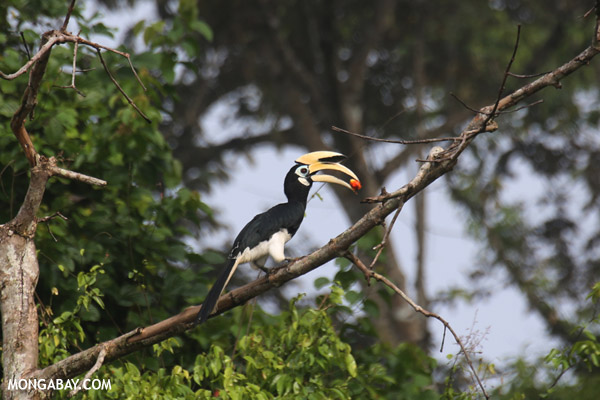
Many species depend on primary forests. Some hornbill species require old-growth forests for nesting sites. Photo by: Rhett A. Butler.
So, what can be done?
The paper’s authors offer four suggestions to change the declining trends of the world’s primary forests.
The first is for the global community to recognize primary forests as a “matter of global concern” in the international community, according to the paper, and not just a problem in developing countries. Especially since nearly half the world’s primary forests are in rich countries, and many of those are still being destroyed.
“Our analysis highlights that the distribution of primary forest, and rates of forest loss, are shared between developed and developing countries,” the authors write.
The second suggestion is for each nation, and the international community at large, to bring primary forests into their environmental accounting, including recognizing their enhanced ecosystem services.

Stark contrast between primary forest and cleared forest in Sumatra. Indonesia has the world’s highest deforestation rate. Photo by: Rhett A. Butler.
“The U.N. Statistics Division’s work on experimental ecosystem accounts provides the tool for national governments to begin testing and implementing systems that recognize the special ecosystem services, such as water flow and quality, arising from primary forests,” the authors write.
The third suggestion is to prioritize avoided loss of further primary forests. In other words, to actively tackle the problem by safeguarding the world’s remaining primary forests, instead of simply reacting after a forest is lost or degraded.
One way this could be easily achieved is by changing priorities within the UN Program to use forests to combat climate change known as Reducing Emissions from Deforestation and Degradation (REDD+). The authors recommend that REDD+ prioritize conservation of primary forests—i.e. avoided loss—above other forest management recommendation such as enhancing forest carbon or increasingly logging sustainability. If REDD+ placed conservation of primary forests a the top it would be a “powerful lever that could significantly direct REDD+ investments in ways that provide incentives for national governments, local communities, and private landowners to protect primary forests,” said Mackey.
He further warned that “if this prioritization is not adopted, then REDD+ funds could end up doing little more than subsidizing industrial logging companies to undertake reduced impact logging/variable retention harvesting as presumed mitigation activities. Given the global distribution of primary forest, the need for international policies that direct funds and investments toward conservation actions that avoid emissions from primary forests is relevant in developed as well as developing countries.”
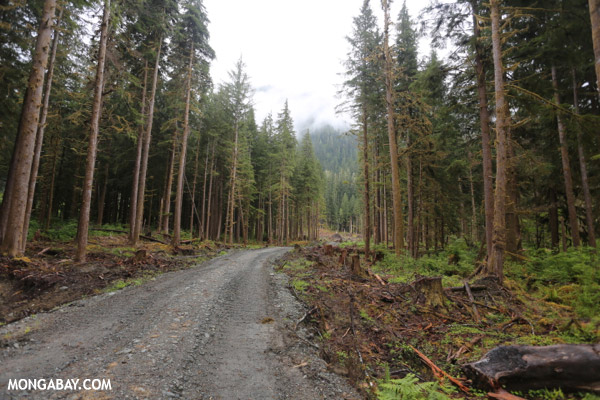
Logging in a secondary forest in the U.S. Photo by: Rhett A. Butler.
Fourth, and last, is to formally accept the role of indigenous people and forest-dwellers in protecting their primary forests—and sustainably using them.
“Local people have strong incentive to preserve the forests they depend on as the basis of traditional subsistence uses including as a source of food, shelter, and medicine,” the authors write. “There are many examples of successful natural ecosystem protection at all scales by local communities.”
One bright side has emerged in recent years: scientists are vastly improving how we monitor primary forests and making that information public. Researchers and policy-makers used to depend on each country self-reporting its extent of primary forests. But today such research is being “vastly improved through real time satellite monitoring such as being implemented by [the World Resources Institute (WRI)],” said Mackey.
WRI recently launched its Global Forest Watch website which depends on various satellite monitoring initiatives to track forest loss worldwide from 2001-2012; the site includes a tool to look at “intact forest landscapes,” which can be used as a proxy for large primary forests.
Scientists are still unsure how long it may take for secondary forests to return to a primary forest state, or if it’s even possible, especially in the tropics. Either way, the timescale of returning to a primary state would likely be centuries, and even then the forest would not necessarily be the same due to biodiversity changes.
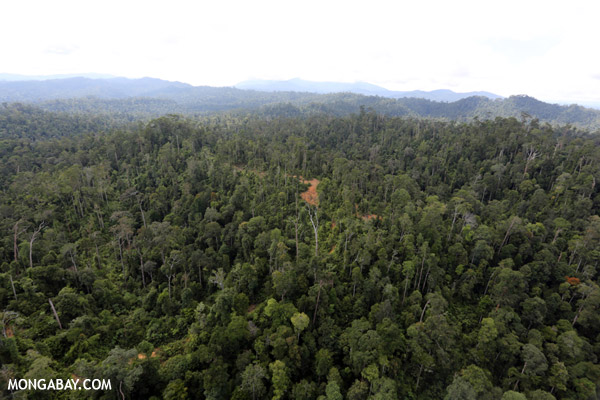
Even selective logging such as this in Sabah, Malaysian Borneo, can cause a forest to lose a number of primary forest qualities. Photo by: Rhett A. Butler.
These 25 countries represent 98 percent of the world’s primary forest, measurements in square kilometers
- 1. Canada: 3,096,632 square kilometers
- 2. Russia: 2,736,141
- 3. Brazil: 2,494,760
- 4. Democratic Republic of the Congo: 647,275
- 5. United States: 587,394
- 6. Peru: 570,594
- 7. Indonesia: 370,780
- 8. Colombia: 354,443
- 9. Venezuela: 315,995
- 10. Bolivia: 230,101
- 11. Papua New Guinea: 163,812
- 12. Guyana: 145,618
- 13. Republic of Congo: 140,799
- 14. Australia: 138,761
- 15. Chile: 110,097
- 16. Gabon: 109,197
- 17. Suriname: 108,733
- 18. French Guiana: 66,352
- 19. Burma/Myanmar: 53,536
- 20. Ecuador: 53,467
- 21. Cameroon: 53,266
- 22. China: 51,138
- 23. Paraguay 45,256
- 24. New Zealand: 42,963
- 25. Argentina: 39,231
Citations:
- Mackey, Brendan, Dominick A. DellaSala, Cyril Kormos, David Lindenmayer, Noelle Kumpel, Barbara Zimmerman, Sonia Hugh et al. “Policy Options for the World’s Primary Forests in Multilateral Environmental Agreements.” Conservation Letters (2014). DOI: 10.1111/conl.12120
Related articles
Selective logging hurts rainforest frogs

(08/21/2014) Selective logging in India’s Western Ghats forests continues to affect frogs decades after harvesting ended, finds a new study published in Biotropica. The research assessed frog communities in logged and unlogged forests in Kalakad Mundanthurai Tiger Reserve and found that unlogged forests had twice the density of frogs as areas logged in the 1970s.

(08/15/2014) Among Russia’s forested lands lie intact forest landscapes (or IFLs). These IFLs are large swaths of unbroken, old growth forests that encompass at least 50,000 hectares, harbor high biodiversity, and have remained mostly undisturbed by development. However, less than 10 percent of the world’s IFLs are currently protected. Now, a new report reveals Russia’s IFLs may be threatened by certified sustainable logging companies.
Ecologists are underestimating the impacts of rainforest logging

(07/31/2014) Ecologists may be underestimating the impact of logging in old-growth tropical forests by failing to account for subtleties in how different animal groups respond to the intensity of timber extraction, argues a paper published today in the journal Current Biology. The study, led by Zuzana Burivalova of ETH Zurich, is based on a meta-analysis of 48 studies that evaluated the impact of selective logging on mammals, birds, amphibians, and invertebrates in tropical forests.
Stuff of fairy tales: stepping into Europe’s last old-growth forest
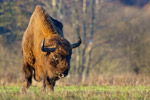
(07/09/2014) There is almost nothing left of Europe’s famed forests, those that provided for human communities for millennia and gave life to the world’s most famous fairytales. But straddling the border between Poland and Belarus, the Bialowieza Forest is Europe’s last lowland old-growth forest, parts of which have never been cut by man.
A fine line: new program predicts when human impact becomes too much

(07/03/2014) Scientists at Stanford University recently unveiled a new modeling program that can predict the response of the environment to the land-use changes of human communities. Using their model, they found that natural resources can support humanity – up to a certain point.
Despite moratorium, Indonesia now has world’s highest deforestation rate

(06/29/2014) Despite a high-level pledge to combat deforestation and a nationwide moratorium on new logging and plantation concessions, deforestation has continued to rise in Indonesia, according to a new study published in Nature Climate Change. Annual forest loss in the southeast Asian nation is now the highest in the world, exceeding even Brazil.
Protecting rainforests could sequester equivalent of a third of global emissions annually

(06/13/2014) liminating deforestation, peatlands and forest degradation, and forest fires in the tropics could reduce global carbon emissions by two billion tons a year, or nearly a fifth, argues a new study published in Global Change Biology. The research analyzed various emissions sources and sinks across the tropics. They found that carbon emissions from activities that damage and destroy forests are nearly counterbalanced by forest regrowth, reforestation, and afforestation.
Logging, fires take a hidden toll on Amazon rainforest

(05/28/2014) Selective logging and small sub-canopy fires are degrading vast areas of rainforest across the Brazilian Amazon, contributing to largely hidden carbon emissions, argues a study published today in Global Change Biology. The research found stark differences in carbon storage between primary forests, selectively logged forests, logged and burned forests, and regrowing or secondary forests.
Borneo bests Amazon in terms of giant tree growth rates
(05/11/2014) Trees in the rainforests of Borneo have faster growth rates than those in the Amazon, finds a study published in the Journal of Ecology.
Reduced impact logging failing to cut emissions in Indonesia
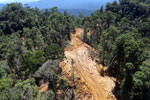
(02/10/2014) Advocates for reduced impact logging in tropical forests often make a case that better forest management cuts carbon emissions relative to traditional forms of timber harvesting. While the argument for altering logging approaches to limit forest damage makes intuitive sense, a new study suggests that the carbon benefits may not bear out in practice.
Next big idea in forest conservation? Incentivizing keeping primary forests intact

(02/07/2014) Much of Dr. Corey Bradshaw’s work has a singular aim: to keep primary habitats and functioning ecosystems intact. According to Bradshaw, the existing system of carbon trading rules needs to be changed so that primary forests are given a higher value than other forms of land use. ‘Nothing, can replace primary vegetation, both in terms of biodiversity value and other ecosystem services.’